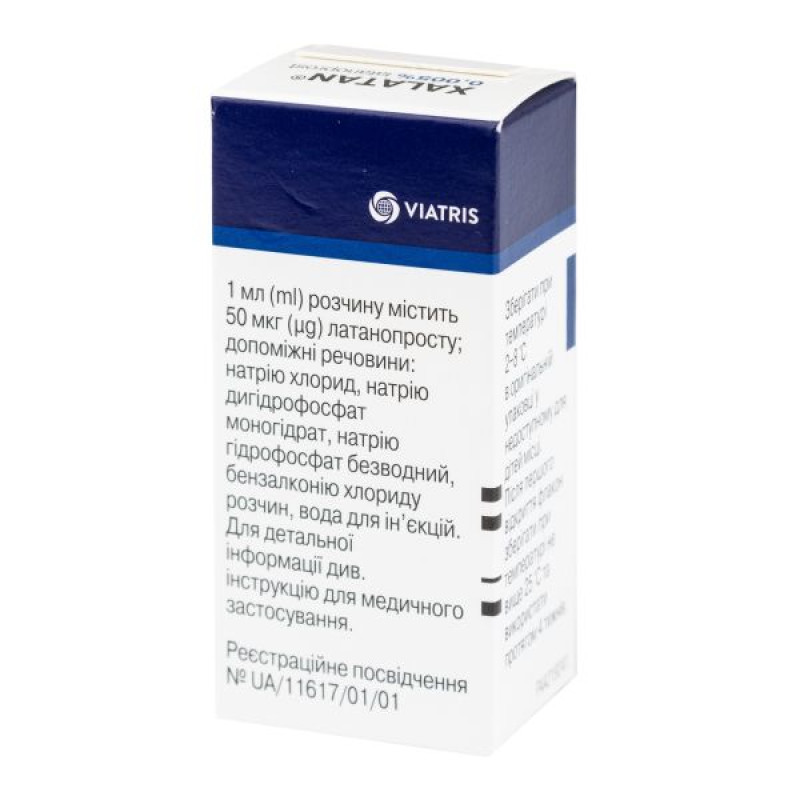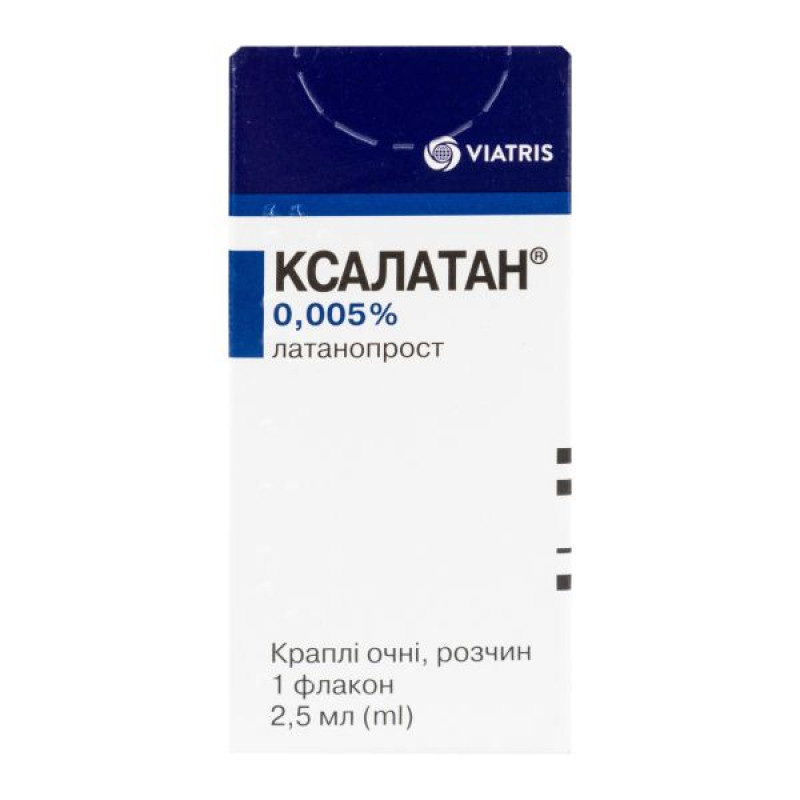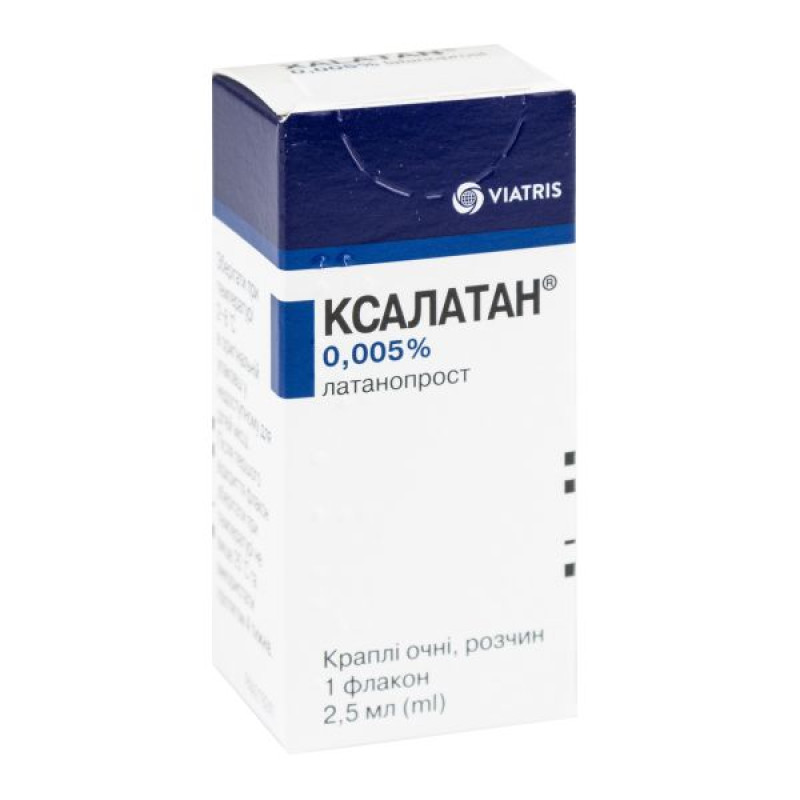Xalatan eye drops 0.005% bottle 2.5 ml

Instructions for use Xalatan eye drops 0.005% bottle 2.5 ml
Composition
active ingredient: latanoprost;
1 ml of eye drop solution contains 50 mcg of latanoprost;
Excipients: sodium chloride, sodium dihydrogen phosphate monohydrate, sodium hydrogen phosphate anhydrous, benzalkonium chloride solution, water for injections.
Dosage form
Eye drops, solution.
Main physicochemical properties: transparent colorless solution.
Pharmacotherapeutic group
Ophthalmic preparations. Antiglaucoma preparations and miotics. Prostaglandin analogues. ATX code S01E E01.
Pharmacological properties
Pharmacodynamics.
The active substance latanoprost, a prostaglandin F2a analogue, is a selective agonist of the prostanoid FP receptor, which reduces intraocular pressure by increasing the outflow of aqueous humor. The reduction in intraocular pressure in humans begins approximately 3–4 hours after administration of the drug, and the maximum effect is observed after 8–12 hours. The hypotensive effect lasts for at least 24 hours.
Basic studies have shown that Xalatan® is effective as monotherapy. In addition, clinical studies of the combination use of the drug have been conducted. These included studies that showed that latanoprost is effective in combination with beta-blockers (timolol). Short-term (1 or 2 weeks) studies show that the effect of latanoprost is additive when used in combination with adrenergic agonists (dipivalyl epinephrine), oral carbonic anhydrase inhibitors (acetazolamide) and at least partially additive when used with cholinergic agonists (pilocarpine).
Clinical studies have shown that latanoprost does not significantly affect the production of intraocular fluid. No effect of latanoprost on the blood-ophthalmic barrier was detected.
Latanoprost did not cause fluorescein leakage in the posterior segment of human pseudophakic eyes during short-term treatment.
No significant pharmacological effects of latanoprost at clinical doses on the cardiovascular and respiratory systems were detected.
Children.
The efficacy of Xalatan® in pediatric patients ≤ 18 years of age was demonstrated in a 12-week, double-blind, clinical trial of latanoprost versus timolol in 107 patients diagnosed with intraocular hypertension and pediatric glaucoma. In this study, the gestational age of the neonates was at least 36 weeks. Patients received 0.005% latanoprost once daily or 0.5% timolol (or optionally 0.25% for patients <3 years of age) twice daily. The primary efficacy endpoint was the mean reduction in intraocular pressure (IOP) from baseline at week 12 of the study. The mean IOP reductions in the latanoprost and timolol groups were similar. In all age groups studied (birth to 3 years, 3 to 12 years and 12 to 18 years), the mean IOP reduction at week 12 of the study was similar in patients treated with latanoprost and patients treated with timolol. However, data on the efficacy of latanoprost in the age group of patients from birth to 3 years were obtained for only 13 patients and no significant efficacy was shown in the 4 patients who represented the age group from birth to 1 year in the clinical study. Data on use in premature newborns (born before 36 weeks of gestation) are not available.
IOP reduction rates in the subgroup of patients with primary congenital glaucoma/infantile glaucoma (PCG) were similar in patients treated with latanoprost and patients treated with timolol. Results in the non-PCG subgroup (i.e. patients with e.g. juvenile open-angle glaucoma, aphakic glaucoma) and PCG patients were similar.
The effect on IOP was evident after the first week of treatment (see table) and was maintained throughout the 12-week study, similar to that in adults.
Table: IOP reduction (mmHg) at week 12 of the study by active treatment group and initial diagnosis
Latanoprost
N=53
Timolol
N=54
Mean baseline value (MB)
27.3 (0.75)
27.8 (0.84)
Change from mean baseline at week 12†(SD)
-7.18 (0.81)
-5.72 (0.81)
p-value compared to timolol
0.2056
PVG
N=28
Non-PVG
N=25
PVG
N=26
Non-PVG
N=28
Mean baseline value (MB)
26.5 (0.72)
28.2 (1.37)
26.3 (0.95)
29.1 (1.33)
Change from mean baseline at week 12†(SD)
-5.90 (0.98)
-8.66 (1.25)
-5.34 (1.02)
-6.02 (1.18)
p-value compared to timolol
0.6957
0.1317
SD - standard error.
†Adjusted estimate based on analysis of covariance (ANCOVA) model.
Pharmacokinetics.
Absorption.
Latanoprost (molecular weight 432.58) is the isopropyl ester of the active substance, i.e. a prodrug that is inactive in itself, but after hydrolysis to form latanoprost acid, it becomes biologically active.
Prodrugs penetrate the cornea well, and all drugs that enter the intraocular fluid are hydrolyzed while passing through the cornea.
Studies in humans have shown that maximum concentrations in the intraocular fluid are reached approximately 2 hours after topical application.
Biotransformation and excretion.
Latanoprost acid is practically not metabolized in the eye. The main metabolism of the drug occurs in the liver. In humans, the plasma half-life is 17 minutes.
Children.
An open-label study of the pharmacokinetics of latanoprost acid plasma concentrations in adult and pediatric patients (from newborns to children up to 18 years of age) with intraocular hypertension and glaucoma was conducted. Patients in all age groups were treated with 0.005% latanoprost, one drop in each eye, for a minimum of 2 weeks. The systemic exposure to latanoprost acid was approximately twice as high in patients aged 3 to < 12 years and 6 times higher in children up to 3 years of age than in adults, but there was a wide safety margin for systemic adverse effects. The median time to peak plasma concentrations was 5 minutes after dosing in all age groups. The median plasma half-life was short (less than 20 minutes), similar for children and adults, suggesting no accumulation of latanoprost acid in the circulation at steady state.
Indication
Reduction of elevated intraocular pressure in adult patients, including elderly patients, with open-angle glaucoma and elevated intraocular pressure.
Reduction of elevated intraocular pressure in pediatric patients with elevated intraocular pressure and pediatric glaucoma.
Contraindication
Known hypersensitivity to any component of Xalatan®.
Interaction with other medicinal products and other types of interactions
There are no comprehensive data on interactions with other drugs.
Paradoxical increases in intraocular pressure have been reported following concomitant ocular administration of two prostaglandin analogues. Therefore, concomitant use of two or more prostaglandins, prostaglandin analogues or their derivatives is not recommended.
Drug interaction studies have only been conducted in adult patients.
Application features
Xalatan® may cause a gradual change in eye color by increasing the amount of brown pigment in the iris. Patients should be informed of the possibility of permanent eye color change before treatment begins. Treatment of only one eye may result in permanent heterochromia.
Eye colour changes are observed mainly in patients with mixed iris colours, e.g. blue-brown, grey-brown, yellow-brown or green-brown. In studies with latanoprost, the onset of colour changes usually occurred within the first 8 months of treatment, rarely during the second or third year and was not observed after the fourth year of treatment. The progression of iris pigmentation decreases over time and stabilises after 5 years. The effect of increased pigmentation after 5 years of treatment with the drug has not been evaluated. In an open-label 5-year safety study with latanoprost, 33% of patients were reported to have increased iris pigmentation (see section 4.8). Iris colour changes are in most cases minor and often clinically unnoticeable. The incidence in patients with mixed iris colours ranged from 7% to 85%, with patients with yellow-brown irises having the highest incidence. Eye color changes were not observed in patients with uniform blue eye color and were rare in patients with uniform gray, green, or brown eye color.
The color change is due to an increase in melanin content in the stromal melanocytes of the iris, and not to an increase in the number of melanocytes. Typically, the brown pigmentation around the pupil spreads concentrically towards the periphery of the affected eye, but the entire iris or parts of it may become more brown. After discontinuation of treatment, no further increase in brown pigmentation of the iris has been observed. To date, there is no evidence in clinical studies that this phenomenon is associated with any symptoms or pathological changes.
Experience with Xalatan® is limited in chronic angle-closure glaucoma, open-angle glaucoma in patients with pseudophakia, and pigmentary glaucoma. There are currently no data on the use of Xalatan® in inflammatory and neovascular glaucoma or in inflammatory eye diseases. Xalatan® has no or negligible effect on the pupil, but there are no data on the use of the drug in acute attacks of angle-closure glaucoma. Therefore, it is recommended to use Xalatan® with caution in such conditions until more data are available.
There are limited data on the use of Xalatan® in the perioperative period for cataract surgery. Xalatan® should be used with caution in such patients.
Xalatan® should be used with caution in patients with a history of herpetic keratitis, but its use should be avoided in cases of active keratitis caused by the herpes simplex virus and in patients with a history of recurrent herpetic keratitis, especially associated with prostaglandin analogues.
Cases of macular edema have been reported (see section 4.8), mainly in aphakic patients, in pseudophakic patients with torn posterior lens capsule or anterior chamber lenses, and in patients with known risk factors for cystic macular edema (such as diabetic retinopathy and retinal vein occlusion). Xalatan® should be used with caution in aphakic patients, in pseudophakic patients with torn posterior lens capsule or anterior chamber lenses, or in patients with known risk factors for cystic macular edema.
Xalatan® should be used with caution in patients with known risk factors for the development of iritis/uveitis.
Experience in patients with bronchial asthma is limited, although some cases of exacerbation of bronchial asthma and/or dyspnea have been reported in the post-marketing period. Until sufficient clinical experience has been gained, the drug should be prescribed with caution to patients with bronchial asthma, see also section "Adverse reactions".
Periorbital skin discoloration has been observed, with the majority of cases occurring in Japanese patients. Currently available data suggest that periorbital skin discoloration is not permanent and in some cases has resolved with continued treatment with Xalatan®.
Latanoprost may gradually change the eyelashes and vulva around the injected eye and in surrounding areas; these changes include increased length, thickness, pigmentation, and number of hairs in the eyelashes or vulva, as well as growth of eyelashes in the wrong direction. Changes in eyelashes are reversible and disappear after discontinuation of the drug.
Preservative.
Xalatan® contains benzalkonium chloride, which is often used as a preservative in ophthalmic preparations. There is no difference in the adverse effect profile in children compared to adults according to the limited available data. In general, however, the ocular response to an irritant is stronger in children than in adults. Irritation may lead to treatment failure in children. Benzalkonium chloride has been reported to cause eye irritation, a symptom of dry eye, and may affect the tear film and corneal surface. It should be used with caution in patients with dry eyes and in patients who may have damaged corneas. With prolonged use, patients should be closely monitored.
Contact lenses.
Contact lenses may absorb benzalkonium chloride, so they should be removed before using Xalatan®, but can be put back in 15 minutes (see section “Method of administration and dosage”).
Use during pregnancy or breastfeeding
Pregnancy.
The safety of this medicinal product for use in pregnant women has not been established. Its pharmacological action poses a potential risk to the course of pregnancy, to the fetus or to the newborn. Therefore, Xalatan® should not be used during pregnancy.
Breast-feeding.
Latanoprost and its metabolites may pass into breast milk, therefore, nursing mothers should discontinue treatment with Xalatan® or discontinue breastfeeding.
Ability to influence reaction speed when driving vehicles or other mechanisms
Xalatan® has a minor effect on the speed of reaction when driving or using other mechanisms. As with other drugs, instillation of eye drops may cause temporary blurred vision. Until this effect has passed, patients should not drive or operate machinery.
Method of administration and doses
Recommended dose for adults, including the elderly.
Recommended therapy: 1 drop in the affected eye once a day. The optimal effect is achieved when using Xalatan® in the evening.
Xalatan® should not be used more often than once a day, as it has been shown that more frequent use reduces the effectiveness of reducing intraocular pressure.
If a dose is missed, treatment should be continued by taking the next dose at the usual time.
As with any eye drops, to reduce possible systemic absorption during instillation, it is recommended to compress the lacrimal sac in the medial canthus of the eye for 1 minute (punctal occlusion). This should be done immediately after instillation of each drop.
Contact lenses should be removed before instilling eye drops and can be reinserted after 15 minutes.
When using multiple topical ophthalmic agents, the drugs should be applied at least 5 minutes apart.
Children
Xalatan® can be used in pediatric patients with the same dosage as for adults.
Data on the efficacy and safety of the drug in the age group up to 1 year are very limited (4 patients) (see section "Pharmacological properties"). There are no available data on the use in premature infants (born before 36 weeks of gestation).
In children aged birth to 3 years, who suffer mainly from primary congenital glaucoma, surgical intervention (e.g., trabeculotomy/goniotomy) remains the first-line treatment.
The long-term safety of the drug in children has not been established.
Overdose
Symptoms.
Apart from eye irritation and conjunctival hyperemia, no other ocular side effects have been reported with an overdose of Xalatan®.
Treatment.
The following information may be useful in the event of accidental ingestion of Xalatan®. One vial contains 125 mcg of latanoprost. More than 90% is metabolized during the first pass through the liver. Intravenous infusion of the drug at a dose of 3 mcg/kg to healthy volunteers did not cause any symptoms, but at a dose of 5.5–10 mcg/kg it caused nausea, abdominal pain, dizziness, increased fatigue, hot flashes and sweating.
However, when topically applied to the eyes at doses of latanoprost 7 times higher than the clinical dose of Xalatan®, bronchostenosis was not observed in patients with moderate bronchial asthma.
In case of overdose with Xalatan®, symptomatic treatment should be carried out.
Adverse reactions
The majority of adverse events are related to the eyes. In an open-label 5-year study of latanoprost, changes in iris pigmentation were reported in 33% of patients (see section 4.4). Other ophthalmic adverse events are usually transient and occur after administration of the drug.
Adverse reactions are categorized according to their frequency of occurrence as follows: very common (≥ 1/10), common (≥ 1/100, < 1/10), uncommon (≥ 1/1000, < 1/100), rare (≥ 1/10000, < 1/1000) and very rare (< 1/10000), not known (cannot be estimated from the available data).
Infectious and parasitic diseases
Rare: herpetic keratitis*§.
Nervous system disorders
Uncommon: headache*; dizziness*.
Vision disorders
Very common: hyperpigmentation of the iris; mild or moderate conjunctival hyperemia; eye irritation (burning sensation with a sensation of "sand in the eyes", itching, burning and sensation of a foreign body in the eye); changes in eyelashes and vellus hair of the eyelids (increase in length, thickness, pigmentation and number of eyelashes).
Common: punctate keratitis, mostly asymptomatic; blepharitis; eye pain; photophobia; conjunctivitis*.
Uncommon: eyelid oedema; dry eye; keratitis*; blurred vision; macular oedema including cystoid macular oedema*; uveitis*.
Rare: iritis*; corneal edema*; corneal erosion; periorbital edema; trichiasis*; distichiasis; iris cyst*§; local skin reaction on the eyelids; darkening of the palpebral skin of the eyelids; ocular conjunctival pseudopemphigoid*§.
Very rare: periorbital and eyelid changes leading to deepening of the eyelid crease.
Heart disorders
Uncommon: angina pectoris; palpitations*.
Very rare: unstable angina.
Respiratory, thoracic and mediastinal disorders
Uncommon: bronchial asthma*; dyspnoea*.
Rare: exacerbation of bronchial asthma.
Gastrointestinal disorders.
Uncommon: nausea*; vomiting*.
Skin and subcutaneous tissue disorders
Uncommon: skin rash.
Rare: itching.
Musculoskeletal and connective tissue disorders
Uncommon: myalgia*, arthralgia*.
General disorders and administration site conditions
Uncommon: chest pain*.
* Adverse drug reaction identified in the post-marketing period.
§ The frequency of adverse drug reactions was assessed using the “Rule of Three”.
There have been very rare reports of corneal calcification in association with the use of phosphate-containing eye drops in some patients with significantly damaged corneas.
Children.
In two short-term clinical studies (<12 weeks) involving 93 (25 and 68) paediatric patients, the safety profile was similar to that in adults and no new adverse events were identified. The short-term safety profiles in the different paediatric patient subgroups were also similar (see section 5.1). The following adverse events were observed more frequently in paediatric patients than in adults: nasopharyngitis and fever.
Reporting of suspected adverse reactions after the marketing authorisation of a medicinal product is essential. This allows for continuous monitoring of the risk/benefit balance of the medicinal product. Qualified healthcare professionals are asked to report any suspected adverse reactions.
Expiration date
3 years.
Storage conditions. Store at 2–8 °C in the original packaging out of the reach of children. After first opening, store the bottle at a temperature not exceeding 25 °C and use within 4 weeks.
Packaging
2.5 ml in a polyethylene bottle. 1 bottle in a cardboard box.
Vacation category
According to the recipe.
Producer
Pfizer Manufacturing Belgium.
Location of the manufacturer and its business address
Rijksweg 12, Puurs-Sint-Amands, 2870, Belgium.
There are no reviews for this product.
There are no reviews for this product, be the first to leave your review.
No questions about this product, be the first and ask your question.








